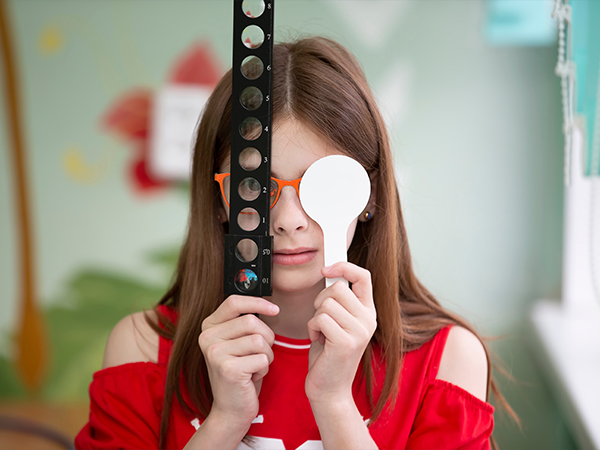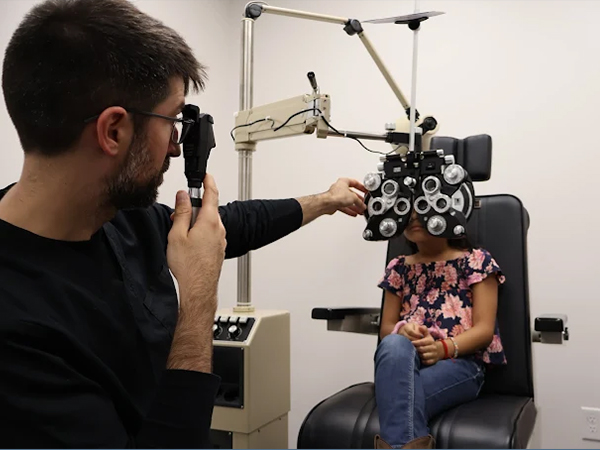How Vision Therapy Helps With Light Sensitivity & Dizziness

Why These Hidden Visual Issues May Be the Missing Piece After Concussion or Chronic Symptoms
Imagine This:
You walk into the grocery store. The fluorescent lights seem painfully bright. The aisles feel like they’re shifting under your feet. You try to focus, but your eyes struggle to keep up. You feel dizzy, disoriented, maybe even a little panicked.
You see a doctor, then another. Your eye exam says you see with 20/20 eyesight and the pictures the doctor took are clear. So why do you still feel off?
If this sounds familiar, you’re not alone and you’re not imagining things.
What many people don’t realize is that symptoms like light sensitivity and dizziness are often signs of a disrupted visual system, especially after you have experienced a concussion or a head trauma. And contrary to popular belief, the solution may not be more rest, more screens off, or more sunglasses. In many cases, the solution is vision therapy.
What Causes Light Sensitivity and Dizziness?
Light sensitivity (also called photophobia) and visual dizziness are more than just eye problems—they’re brain-eye coordination problems. After a head injury, illness, or even prolonged stress, the delicate systems responsible for helping you make sense of your visual world can go offline.
Common triggers include:
Concussion or mild traumatic brain injury
Vestibular disorders (inner ear imbalances)
Binocular vision dysfunction (when the eyes don't work together properly)
Sensory overload from environments with lots of movement, patterns, or bright lighting
Even in the absence of a known injury, some people have subtle visual problems that were never diagnosed—and these can be pushed into awareness by stress, fatigue, or a sudden change in routine.
Your Visual System Does More Than See
When we talk about vision, we often think of sharpness or clarity—20/20 eyesight. But functional vision is much more complex.
Your visual system helps you:
Stay balanced and oriented in space
Process motion without getting dizzy
Stabilize your vision while moving your head or walking
Shift your focus quickly between distances
Tolerate light and movement in busy environments
When these systems aren’t working properly, your world can feel overwhelming. Grocery stores, classrooms, screens, and even conversations can trigger symptoms.
And here’s the important part: you can still have perfect eyesight but a dysfunctional visual system.
How Vision Therapy Helps
Vision therapy is like physical therapy for the eyes and brain. It uses guided activities and specialized tools to retrain the way your visual system processes and responds to input.
At our clinic, we’ve seen vision therapy help patients:
Reduce or eliminate light sensitivity
Regain comfort in visually busy environments
Stabilize balance and reduce dizziness
Feel more confident navigating daily life
Therapy may include:
Eye teaming and tracking exercises
Balance and visual-vestibular integration activities
Filtered or prism lenses to help re-stabilize visual input
Syntonic phototherapy (if indicated) to support neurological recovery
Gradual re-exposure to complex environments in a structured way
Over time, these approaches help the brain build stronger, more efficient visual processing pathways—allowing symptoms to fade and function to return.
One Patient’s Story
After her concussion, Maria, a 14-year-old soccer player, couldn’t go outside without sunglasses. Bright lights triggered headaches. Grocery stores made her dizzy. Her doctors told her to rest, but months later, she still couldn’t return to school full time.
After a functional vision evaluation, we identified a convergence insufficiency and began vision therapy. Within weeks, her tolerance for light improved. She began tracking movement more smoothly. And after a few months, she was back on the field, with no sunglasses needed.
When Should You Seek Help?
If you or your child experience any of the following, it’s worth exploring a functional vision evaluation:
Light sensitivity that persists after an illness or injury
Dizziness in visually busy environments (like grocery stores, gyms, or hallways)
Trouble reading or using screens for more than a few minutes
Feelings of disorientation or imbalance with no clear medical cause
Symptoms that don’t resolve after a concussion—even if the scans look fine
These are signs your visual system is under strain, and it may not resolve on its own.
What Is a Functional Vision Evaluation?
Unlike a routine eye exam, a functional vision evaluation assesses:
Eye teaming and tracking
Visual balance and spatial awareness
Peripheral vision and depth perception
Visual-vestibular integration
How your brain interprets and organizes visual information
This evaluation gives us a clear picture of what’s working—and what’s not—so we can create a therapy plan tailored to your needs.
You Don’t Have to Stay in the Dark
Living with light sensitivity and dizziness can be isolating and frustrating—especially when it feels like no one can find the cause. But the answer might be hidden in plain sight.
Your visual system may need help.
And with the right therapy, healing is possible.


